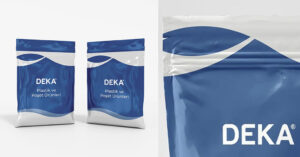The zipper ziplock bag has a wide range of uses from food hygiene safety to the transportation of industrial products. Since behind the opening and closing mechanism, which seems simple to the user, there is the correct selection of plastic materials, film production techniques, zipper assembly and meticulous quality control processes, the slightest mistake made on the production line can negatively affect the sealing or durability of the bag. For this reason, the production stages are planned not only from an engineering point of view, but also in line with food safety and consumer expectations. Zippered refrigerator bags, zippered storage bags or more industrial zippered plastic bags are all produced using similar principles, but the raw materials and testing criteria vary depending on the intended use.
Raw Material Selection Determines the Durability of the Zipper Ziplock Bag
The most commonly used materials in the production of zip-lock bags are polyethylene (PE) with its flexibility and structure that does not break even at low temperatures, and polypropylene (PP) polymers with their transparency and high heat resistance. These two materials can be used alone or in combination, especially in transparent zipper bags or multilayer film structures that require high barrier properties.
The choice of raw material directly affects not only durability but also food contact compatibility. Since national and international authorities require food contact plastics to pass certain migration tests, it is mandatory for manufacturers to request food contact compatibility certificates when procuring raw materials. In addition, the polymer used for the zipper part must be compatible with the body film in order to prevent separation or opening at the welding points in products with an open-close mechanism such as zipper-lock bags. Therefore, not only price but also long-term performance and compliance with standards are decisive in raw material selection.
Extrusion and Film Production Processes
The film production stage, which is the process after the raw material is determined, is usually done with a technique called extrusion. The granulated plastic is melted at high temperature and formed into film by inflating it into a thin layer or by passing it through straight-line molds. The thickness, homogeneity and clarity of the film obtained in this process are the main features that directly affect the overall performance of the bag. For example, if the zip lock bag is produced for food products, a film with high oxygen and moisture barrier is preferred, while a film produced for industrial use ziplock bag with zipper thicker and puncture resistant.

The machine settings used in the extrusion stage play a critical role in preventing defects in the film. Temperature imbalance can lead to wavy film or weak spots. In addition, coloring or pre-printing primer applications are made at this stage if desired. While transparent film is commonly used in food packaging, opaque film is preferred for protection against light in some types of zippered plastic bags. Each roll of film coming out of production is checked for surface tension and thickness to ensure smooth progress in the subsequent zipper assembly and cutting stages. So film production is not only the first step, but also the cornerstone of the entire process.
Zipper Assembly and Cut Welding Ensures Durability of the Structure
The film produced in the extrusion stage is prepared in rolls of specific widths and then routed to the lines where the zipper will be integrated. The zipper parts used in the production of zip-lock bags are usually made of polyethylene or polypropylene-based polymers. These polymers are welded to the top edge of the film with the help of special machines. The welding process here ensures the fusion of the film and zipper with high temperature, but if the welding is insufficient, the zipper line may separate from the film during opening and closing and the product will lose its function.
Not only is the zipper adhesion critical during the assembly phase, but also proper alignment. In designs known as ziplock zipper pouches, the machines are equipped with precise guides and sensors, as an oblique or asymmetrical zipper line will cause the pouch not to close properly. The film is cut into pouch form after assembly. The cutting and welding machines perform both cutting and edge welding processes at the same time while running at high speed. In plastic zipper bags, the extra welding on the bottom reduces the risk of tearing during transportation.
At the last stage, the bags are optionally labeled with brand or product information by passing through the printing line. Preparing the surface before printing with corona or plasma treatment makes it easier for the ink to remain fixed on the film. These assembly and cutting welding steps throughout production are among the most critical techniques that directly affect the lifetime of the pouch.
Are Quality Control Tests Required for Zipper Ziplock Bags?

Regardless of zipper bag prices, tests that measure the reliability and durability of the product are part of the standards. Quality control is not limited to visual inspection, but also tests the seal, physical durability and content protection properties of the pouch.
Firstly, leakage tests are performed to determine whether the pouch is leaking air or liquid from the zipper line or welding points. Positive and negative pressure tests are performed using the air bubble method or gas leakage measurements in a tank full of water. When zipper pouches are used for food, these checks are especially important as even the smallest leakage can shorten the shelf life of the product.
In addition, strength tests such as tensile tests, tests that measure the durability of the zipper line during opening and closing, burst and puncture tests that show how resistant the bag is to the pressures it will be exposed to during transportation. In zipper pouch models, the number of open-close cycles is also measured and if the zipper fails below a certain number, the batch is discontinued.
Barrier performance tests, another quality control test, measure the permeability to oxygen, carbon dioxide and water vapor, especially in food contact products such as zipper storage bags. Odor transfer is also examined when necessary. Food safety standards require these barrier values to be below certain thresholds.
Quality control steps give confidence not only to the manufacturer but also to the consumer because they guarantee that the product is compatible with its intended use.
Do Tightness Tests Reveal the Risk of Leakage?
When using a ziplock zipper bag, manufacturers apply positive and negative pressure tests as the consumer expectation is that the product will not leak air or liquid.
At positive pressure, the bag is inflated from the inside and leakage is observed. At negative pressure, the external pressure is increased to check for leakage from the inside to the outside. Bubble testing in a water tank is a practical but effective method; the slightest air leakage will cause the pouch to be eliminated before it reaches the market. In more advanced applications, even microscopic leaks can be detected using helium spectrometry. This type of testing is essential to ensure a safe shelf life, especially for food contact products such as primplast zipper pouches.
Strength Tests Measure the Physical Durability of the Bag
For roll up zipper bags or thick type bags produced for industrial use, the risk of tearing the bag during load handling is evaluated. Tensile tests are applied to the zipper line to measure how strongly it separates during opening and closing.
In the burst test, the bag is filled with air from the inside to determine the maximum pressure it can withstand. Puncture tests measure resistance to sharp or pointed objects. Since the zipper bag is expected to be opened and closed hundreds of times when it reaches the consumer, the opening and closing life of the zipper is tested. As a result of these cycle tests, it must be verified that the zipper line is intact and maintains its function.
Are Barrier performance tests Adequate to Protect Content?
Barrier values are very important, especially for transparent zipper bags or products with a special additive film structure used in the food and pharmaceutical industry.
- Oxygen permeability is measured to estimate the duration of product protection against spoilage.
- The water vapor permeability test is applied for products with high moisture sensitivity.
- In some cases, odor transfer is also checked, as spices stored in a zippered plastic bagare not expected to emit or absorb odors from the outside environment.
These barrier tests are one of the most important indicators proving that manufacturers produce in compliance with national and international food packaging standards.
All the steps in the production line, starting from raw material selection, extrusion, zipper assembly, cutting and quality control tests, ensure the safety and longevity of the zipper ziplock bag. A zipper storage bag used in daily life and a more durable model preferred in industry are both produced with similar principles, but the testing and quality criteria differ according to the intended use, as this product, which seems simple for the user, is based on the engineering production process carried out with high precision behind it.


